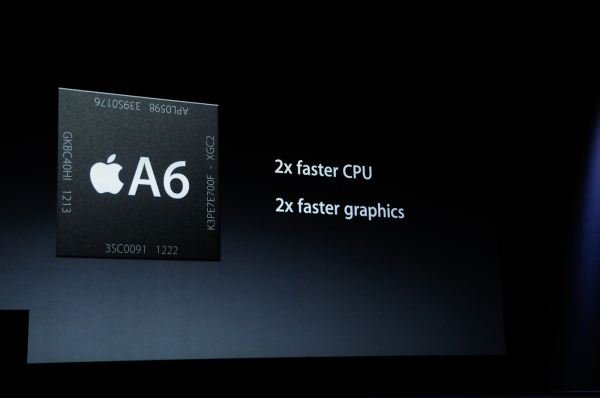Apple A6 reportedly a custom ARM CPU, PowerVR SGX 543MP3, 1GB of RAM

At the iPhone 5 event on September 12, Apple not only announced a new iPhone, but also a new system-on-a-chip (SoC) sequentially named the Apple A6, While we'd heard about this new chipset prior to the event, we hadn't heard anything specific. Rumors ranged from an updated, higher clocked version of last year's dual-core ARM Cortex A9-based Apple A5 with a PowerVR SGX543MP2 GPU, to a bleeding edge ARM A15 and PowerVR 6 "Rogue". Turns out the Apple A6 is nothing as conservative or futuristic as either of those things -- it's something even more exciting. It's Apple's first custom-designed ARM chipset. Anand Lal Shimpi of Anandtech did some investigating and came up with what he believes are the details:
The A6 is the first Apple SoC to use its own ARMv7 based processor design. The CPU core(s) aren't based on a vanilla A9 or A15 design from ARM IP, but instead are something of Apple's own creation. [..] The deeper machine plus much wider front end and execution engines drives both power and performance up.
He also puts it at 32nm. He isn't clear on the number cores yet, but give the realities of power/performance Apple wants to hit, the same logic seems to dictate dual-core as still being the sweet spot. Licensing the instruction set (ARMv7) rather than the specific processor (like Cortex A9 or A15) is an interesting move for Apple. It's similar to what Qualcomm for the Krait.
As for that GPU, he pegs it at a PowerVR SGX 543MP3 clocked "marginally" higher:
The [PowerVR SGX 543MP3] is sort of the best of both worlds. You don't take a huge die area penalty and at the same time don't run at a significantly higher frequency, and you can get to that same 2x value. The third option is the most elegant and likely what Apple chose here. Remember that overall die size is dictated by the amount of IO you have around the chip.
Apple has always branded their versions of ARM chipsets, with the iPhone, iPhone 3G, and iPhone 3GS all bearing the logo if not the name. With the iPad (and later iPhone 4), Apple introduced the Apple A4 and the line took on a public naming convention. That continued with the iPad 2 and iPhone 4S SoC, named Apple A5, and the iPad 3 SoC, named Apple A5X. Through the years, Apple also bought chip companies PA Semi and Intrisity, hired and later let go IBM chip-whiz Mark Papermaster, hired and later let go Jim Keller, and others.
Making their own ARM chipset instead of licensing one would be the ultimate extension of Apple's desire to make the whole widget, bit to atom. It's something that makes a lot of sense, but felt like it might have been a year or two away still. Not so. If Anand Lai Shimpi is right. it starts now.
Source: Anandtech
iMore offers spot-on advice and guidance from our team of experts, with decades of Apple device experience to lean on. Learn more with iMore!

Rene Ritchie is one of the most respected Apple analysts in the business, reaching a combined audience of over 40 million readers a month. His YouTube channel, Vector, has over 90 thousand subscribers and 14 million views and his podcasts, including Debug, have been downloaded over 20 million times. He also regularly co-hosts MacBreak Weekly for the TWiT network and co-hosted CES Live! and Talk Mobile. Based in Montreal, Rene is a former director of product marketing, web developer, and graphic designer. He's authored several books and appeared on numerous television and radio segments to discuss Apple and the technology industry. When not working, he likes to cook, grapple, and spend time with his friends and family.
